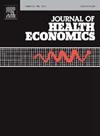Regression and decomposition with ordinal health outcomes
IF 3.6
2区 经济学
Q1 ECONOMICS
引用次数: 0
Abstract
Although ordinal health outcome values are categories like “poor” health or “moderate” depression, they are often assigned values for convenience. We provide results on interpretation of subsequent analysis based on ordinary least squares (OLS) regression. For description, unlike for prediction, the OLS estimand’s interpretation does not require that the are cardinal values: it is always the “best linear approximation” of a summary of the conditional survival functions. Further, for Blinder–Oaxaca-type decomposition, the OLS-based estimator is numerically equivalent to a certain counterfactual-based decomposition of the survival function, again regardless of any cardinal values. Empirically, with 2022 U.S. data for working-age adults, we estimate a higher incidence of depression in the rural population, and we decompose the rural–urban difference. Including a nonparametric estimator that we describe, estimators agree that 33%–39% of the rural–urban difference is statistically explained by income, education, age, sex, and geographic region. The OLS-based detailed decomposition shows this is mostly from income.
有序健康结果的回归和分解
虽然有序健康结果值属于“健康欠佳”或“中度”抑郁等类别,但为了方便起见,它们通常被赋值为1、2、3、…。我们提供了基于普通最小二乘(OLS)回归的后续分析的解释结果。对于描述,与预测不同,OLS估计的解释不要求1,2,3,…是基数值:它总是条件生存函数总结的“最佳线性近似值”。此外,对于blinder - oaxaca型分解,基于ols的估计量在数值上等同于生存函数的某个基于反事实的分解,同样与任何基数值无关。从经验上看,根据2022年美国工作年龄成年人的数据,我们估计农村人口中抑郁症的发病率较高,并对城乡差异进行了分解。包括我们描述的非参数估计量,估计者一致认为城乡差异的33%-39%在统计上可以用收入、教育、年龄、性别和地理区域来解释。基于ols的详细分解显示,这主要来自收入。
本文章由计算机程序翻译,如有差异,请以英文原文为准。
求助全文
约1分钟内获得全文
求助全文
来源期刊

Journal of Health Economics
医学-卫生保健
CiteScore
6.10
自引率
2.90%
发文量
96
审稿时长
49 days
期刊介绍:
This journal seeks articles related to the economics of health and medical care. Its scope will include the following topics:
Production and supply of health services;
Demand and utilization of health services;
Financing of health services;
Determinants of health, including investments in health and risky health behaviors;
Economic consequences of ill-health;
Behavioral models of demanders, suppliers and other health care agencies;
Evaluation of policy interventions that yield economic insights;
Efficiency and distributional aspects of health policy;
and such other topics as the Editors may deem appropriate.
 求助内容:
求助内容: 应助结果提醒方式:
应助结果提醒方式:


